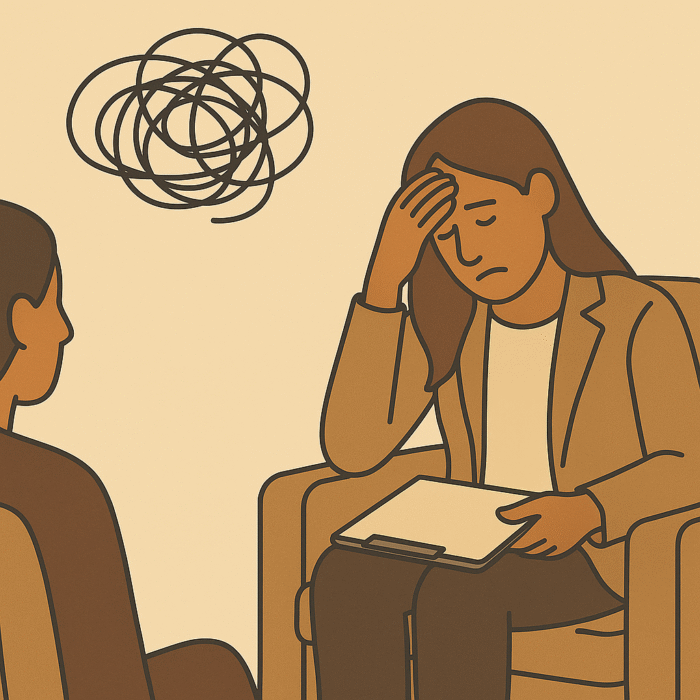As therapists, counsellors, or coaches, we dedicate ourselves to helping others heal, grow, and find meaning. But in doing so, many of us quietly carry a weight of our own. Long hours, emotional intensity, and the pressure to always hold space for others can slowly drain our energy and sense of purpose.
This isn’t weakness — it’s human. Burnout among therapists has been rising steadily across sectors and countries, and it affects not just wellbeing, but also the quality of care we can offer. At Meaningful Paths, we view burnout not as a failure, but as a sign that something vital needs attention — our own meaning, balance, and self-compassion.
The Data: How Prevalent is Burnout Among Therapists?
Understanding the scale of the problem helps normalise the conversation — you’re not alone in feeling this way.
- A study of 165 trauma-therapy providers found 35.2% reported burnout, and that burnout was associated with lower odds of clinically meaningful client improvement. (PMC)
- A systematic review across psychological professions found burnout prevalence ranging from 6% to 54%, with many studies reporting rates between 20% and 67%. (Frontiers in Psychology)
- A UK study of mental-health practitioners reported burnout symptoms in up to 69% of therapists working in high-intensity settings. (White Rose University Consortium)
These figures reveal that therapist burnout is not an exception — it’s a widespread, systemic challenge.
Why It Happens
Therapist burnout doesn’t emerge overnight. It’s the result of cumulative strain — emotional, cognitive, and relational.
- Emotional labour and empathy fatigue: We absorb the pain and stories of others, sometimes without realising how much they weigh on us.
- Systemic pressures: Caseloads, admin demands, and financial instability in private practice add constant low-grade stress.
- Perfectionism and self-expectation: Many therapists feel guilty setting limits or needing rest, believing we must always be available.
- Lack of boundaries: When we give more than we replenish, burnout becomes inevitable.
- Isolation: Unlike many professions, therapists often work alone, which can heighten stress and reduce emotional regulation.
Our recent article, Collaborating Over Competing – A Practitioner’s Guide, explores how building a supportive professional network can reduce isolation and foster collective resilience.

Recognising the Signs
Burnout can feel subtle at first — a dull fatigue, an emotional flatness. Over time, it may evolve into detachment, resentment, or a loss of meaning.
Common signs include:
- Exhaustion: You feel drained before sessions even begin.
- Cynicism or detachment: Emotional numbness toward clients or the work.
- Reduced sense of accomplishment: Questioning your impact or doubting your competence.
- Physical symptoms: Headaches, insomnia, or chronic fatigue.
- Emotional withdrawal: Avoiding challenging cases, or fantasising about leaving the field.
If you’re noticing these patterns, take a pause — not to judge yourself, but to listen. Burnout isn’t a signal to quit; it’s an invitation to realign with what gives your work meaning.
Meaning-Centered Reflection: A Path Through Burnout
From an Existential Analysis perspective, burnout represents a loss of connection — to self, to meaning, or to others. It’s not simply exhaustion; it’s a form of disconnection from purpose.
You may find yourself asking:
- “What’s the point of all this?”
- “Am I really helping anyone?”
- “When did I stop feeling fulfilled?”
These questions, though painful, are deeply human. In fact, they mark the beginning of reorientation. As Viktor Frankl wrote, meaning can always be found — even in suffering — when we ask, “What is life asking of me now?”
If you’re feeling overwhelmed, our piece How Do I Calm My Mind When Everything Feels Too Much? offers grounding tools to help you reconnect with stability and presence.
Steps to Protect and Restore Your Wellbeing
- Revisit Your Why
Reflect on the values that drew you to this work. Realigning with purpose can rekindle motivation and restore balance.
Explore this deeper in Reconnecting with Purpose After a Major Life Change – An Existential Perspective. - Set Compassionate Boundaries
Boundaries are not barriers; they’re expressions of respect — for you and for your clients. Practice saying no where needed, and protect time for rest and reflection. - Cultivate Connection and Peer Support
Therapists thrive in dialogue. Join a peer supervision group, engage in reflective discussion, or participate in spaces that encourage shared vulnerability. - Integrate Recovery Rituals
Recovery isn’t indulgence — it’s part of sustainable practice. Even small rituals (a short walk, journaling, music) can regulate stress and restore balance. - Seek Meaning Beyond Work
Our worth isn’t confined to our professional roles. Meaning flourishes in relationships, creativity, and presence.
Finding Happiness Within Yourself – An Existential Perspective offers guidance for reconnecting with that sense of inner wholeness.
Why Therapist Wellbeing Matters
Research consistently shows that therapist burnout impacts both practitioner and client outcomes. When burnout rises, empathy and attunement decline — but when therapists are grounded, clients progress more effectively.
Taking care of yourself is not selfish; it’s essential to ethical and effective practice. By restoring your own meaning, you model authenticity and self-awareness for your clients.
Support for Therapists and Coaches with Meaningful Paths
At Meaningful Paths, we recognise the deep care and dedication that therapists and coaches bring to their clients — and we know how important it is to sustain your own wellbeing while doing this meaningful work.
Through our Therapists & Coaches Path, you’ll gain access to:
- A free in-app group for therapists and coaches — a reflective, non-judgmental space to share insights, find support, and feel part of a compassionate professional community.
- Practical wellbeing tools grounded in Existential Analysis and Logotherapy, helping you maintain balance, clarity, and purpose in your own practice.
- Reflective exercises and growth resources designed for practitioners who want to deepen self-understanding and sustain long-term resilience.
- Data insights to support your practice, empowering you to better understand your clients and serve your community with evidence-informed approaches.
- Wellbeing tools your clients can use between sessions, enabling ongoing growth, reflection, and integration of therapeutic work.
👉 Explore the Therapists & Coaches Path here — and reconnect with the meaning that first drew you to this work.
Final Reflection
You entered this profession to help others find healing and purpose. But that purpose includes you.
Burnout isn’t an endpoint; it’s an opportunity to pause, reflect, and reimagine how you relate to your work and to yourself. Meaningful Paths exists to accompany you in that process — to help you rediscover the strength and meaning that sustain the heart of your practice.

